2019 KTM 690 Enduro R Review

Spending time with KTM's biggest Single
The 2019 KTM 690 Enduro R fills a niche within a niche. Ask riders of different disciplines where the 690 Enduro R falls among motorcycle segments and you’re likely to get two different answers. To off-road riders, the 690 is an adventure bike. Its big Single is smoothed out by dual counterbalancers, and a nice electronics package sets it apart from the 350 or 500 EXCs and two strokes available in KTM’s enduro/dual-sport range. Ask the same question to a street rider and you get, “It’s a dirtbike”. Dirtbike ergos, dirtbike looks, a big ol’ 693 cc Thumper, and its relatively small size – compared to 1290s – place the Enduro R in off-road territory for asphalt-locked motorcyclists.
2019 KTM 690 Enduro R
| Engine | 18.0/20 |
| Suspension/Handling | 13.5/15 |
| Transmission/Clutch | 7.0/10 |
| Brakes | 9.0/10 |
| Instruments/Controls | 3.5/5 |
| Ergonomics/Comfort | 6.5/10 |
| Appearance/Quality | 8.75/10 |
| Desirability | 7.5/10 |
| Value | 8.0/10 |
| Overall Score | 81.75/100 |
It’s true, the 690 does slide into an interesting space in KTM’s lineup just between the 790 Adventure and 500 EXC-F and with no real direct competitors from any other manufacturer – aside from a certain white one that may even share some componentry – it’s basically in a field of one.
It’s been more than a minute since KTM’s big Single graced the presence of MO’s digital pages, nearly five years to be exact. Yours truly felt that was entirely too long and with the host of upgrades for the 2019 model year, there was no time like the present to jump on the 2019 KTM 690 Enduro R to see what this newly revised travel enduro is capable of.
Kennedy Meadows seemed like a great place to put the Enduro R through its paces (despite MO’s previous misfortunes in the area). The 400-plus mile round trip of mostly freeway riding would provide a great test of the bike’s comfort for longer hauls while the varying trails of the eastern Sequoia National Forest would provide a scenic backdrop with a multitude of terrain options for assessing the off-road performance of the 690.
The night before I planned to set off, I arrived at my first issue. After compiling camping gear and other essentials, I realized neither of the two universal luggage options I had were going to work on the Enduro R; there is simply nowhere to strap anything to the tail of the motorcycle. Not to mention the 3.6-gallon fuel tank – an increase of .4 gallons from 2018 – makes up the subframe of the motorcycle which means even if I was able to strap a bag to the tail section, I would need to remove it in order to gas up. Fortunately, the 690 Enduro R has been around for a while so if you’re a fan of the bike, the aftermarket likely has a solution for most needs from rear racks, to side luggage mounts. I opted to go the minimalist route – not that I had a choice – and packed my Kriega R25 to the max and would simply deal with carrying a backpack. Not a big deal.
A fair amount of the changes for 2019 add to the Enduro R’s road-going prowess. The latest edition of the large 693cc Single-cylinder LC4 engine’s vibes are tamed by not one, but two counterbalancers, one located on the crankshaft and one in the cylinder head. The engine is incredibly smooth at highway speed for having a big ol’ 105 mm piston bouncing up and down in there.
The ride-by-wire throttle and the inclusion of an IMU combine to allow the addition of two ride modes as well as lean sensitive traction control and ABS to the 690. Ride mode one, the street setting, delivers smooth throttle response with cornering-sensitive traction control keeping wheel spin and wheelies to a minimum. Ride mode two is the off-road setting with more aggressive throttle response and offroad traction control allowing rear wheel spin up to a certain degree plus lofting the front wheel. Both traction control and ABS can be disabled in either mode by holding the TC button on the left side of the handlebar for exactly five seconds (no more and no less or it won’t work) while ABS is disabled by holding the triangular ABS button on the dash until it lights up. An accessory dongle can also be purchased to enable off-road ABS which disconnects the system from the rear wheel and uses a slightly less intrusive algorithm for the front. KTM has also thrown its Quickshifter + on the 690 which allows for clutchless upshifting and downshifting, more on that later.
The droning freeway miles up to Kennedy Meadows were easily managed by the updated LC4 engine. Cruising at freeway speeds for hours on end is an easy task that leaves more than enough power and torque in reserve to pull away from cars when needed well into triple-digit speeds. KTM claims 74 horses and 54 lb-ft of torque from the 690 Enduro R. With fuel mileage consistently delivering around 55 mpg, in theory, that puts estimated range at nearly 200 miles from the 3.6-gallon subframe, but if I’m honest, I fueled up with plenty of miles left in the tank each time to ensure that if I did come across the odd dirt road in need of exploration I’d have the range to do so comfortably. There’s also the fact that the seat is so stiff that I could hardly handle going more than 100 miles at a time. An aftermarket seat would be first on the upgrade list for me with the 690.
After a stop at the bottom of 9 Mile Canyon Road my photographer and I ascended into the mountains thoroughly stoked to get off of the scorching valley floor, away from straight roads, and eventually onto the dirt. The smooth and powerful torque delivery on twisty roads is addictive. The motor pulls hard all the way through the rev-range which makes blasting out of corners a thrilling experience. Thrilling until you need to shift. The Quickshifter+ fitted to the 690 Enduro R I was piloting was perhaps the worst I’ve ever used, certainly the worst on a KTM. Upshifts required an enormous amount of pressure regardless of rpm while downshifts were only slightly easier. I quickly abandoned trying to use the quickshifter as it basically felt like it wasn’t equipped. Thankfully, KTM’s Power Assist Clutch does a great job of smoothing out aggressive downshifts and pull at the lever from the hydraulically actuated system is smooth and effortless.
Quickshifter be damned, my excitement as we rolled up to the General Store before heading to score a campsite couldn’t be diminished… or so I thought. The moment the rubber of the 21-inch Conti TKC80 touched the dirt parking lot, horrible sounds began emanating from the right side of the motor, accompanied by a near total loss of pressure at the clutch lever. Unable to disengage the clutch I came to a controlled stop/stall and began to assess the situation. After some deliberation, including a call to KTM and Evans, it was decided that we would need to be rescued. Although I was carrying a tool kit that could have dismantled most of the motorcycle, the lack of replacement parts was the cause of concern from KTM’s side of things. No reason to pull the clutch cover off or clutch slave cylinder if parts needed to be replaced, and since I wasn’t stranded in the middle of nowhere, I didn’t need to resort to measures that could otherwise harm the motorcycle. I had to concede.
I couldn’t believe it. I had made it the entire way up, miles of sitting on that torture rack of a seat only to have my off-road aspirations dashed before they could begin. I knew the 690 Enduro R would be more fun off-road than on, but I was willing to pound out the 170 miles of pavement for you, the reader, rather than trucking the bike to the trails. Three hours later, dejected and much less dirty than I had hoped to be at that point, I waited as Evans rolled up in his truck, we loaded the 690 into the back, and headed home.
Fast forward weeks later…
Here at MO, we don’t give up on bikes so easily. Within a week of KTM having the bike they fixed the issue and returned the motorcycle to us in working order. Turns out the center bolt holding the clutch assembly together had worked its way loose, and the entire clutch pack was spinning against the inside of the clutch cover. C’est la vie.
On with the testing!
After being assured the correct torque spec had been used and maybe even a dash of Loctite, I set a date to get the 690 off the beaten path as soon as possible, and as I had expected, I enjoyed it more off-road.
Once I was able to get the 690 in the dirt, some of the other changes for 2019 began to show just how capable and compliant the big Thumper could be. Fitted with WP’s XPLOR fork and shock, the Enduro R gains even more adjustability than before. The 48 mm fork delivers nearly 10 inches of travel and is adjustable for preload as well as compression and rebound with more than thirty clicks of adjustment available without tools for each. The shock – connected via linkage – also delivers almost 10 inches of travel and is adjustable for both high and low speed compression, rebound, and preload with a similar range of adjustment to the fork. This allows riders to really fine tune the suspension to their riding style or the terrain they most often find themselves on. I generally keep the adjustment in the mid-range since I often encounter rocky terrain and deep sand during the same ride. I’ve sung the praises of the WP XPLOR units before, and these are no different. The damping feels excellent and with the range of adjustment available, characteristics can easily be changed.
The 21-inch/18-inch spoked tube-type wheels are shod with Continental TKC 80s, a favorite in ADV circles for their balance of both on- and off-road performance. Brembo calipers provide great stopping power and modulation at the levers, though the rear took me a bit more time to get used to. Standard protective equipment on the 690 Enduro R includes flag-style handguards, and a plastic skid plate.
Ergonomics are unsurprisingly dirtbike-esque with a high wide handlebar giving more than enough leverage to man handle the big orange bike. Although the seat is hard – and high, at 35.8 inches – the seat cover does provide ample grip, and combined with the rear-mounted fuel tank, allows the rider plenty of room to scoot up to weight the front tire.
Riding the 690 Enduro R through fast trails and fire roads is a blast. The big Single delivers wheel-spinning torque that translates into easily controlled power slides corner after corner even without the off-road TC engaged. If you do like to have that safety net, ride mode 2 will allow the rear to step out, just not as much as I would have liked. The 690 doesn’t have quite the hit that the 500 EXC-F delivers. It takes a little bit longer to spool up that power, but it’s no slouch by any means. Adjusting the electronics did come to be rather annoying off-road. Having to turn off TC and ABS every time the key is cycled off is one thing – although the 690’s routine is more finicky than others – but that can be bypassed by just using the kill switch. The problem is, that didn’t work all of the time. More often than not, if I just used the kill switch to stop briefly on the trail, it would retain TC and ABS off, but every once in a while, for reasons I couldn’t seem to consistently replicate, I’d fire the bike back up and start riding only to realize once I was relying on those systems being off that they had reset to on. Another odd occurrence was that the bike wouldn’t always stay in the same ride mode either. Sometimes the kill switch or key cycling would cause the bike to be in the other mode as indicated on the left side control by a backlit white one or green two. This became quite annoying during a full day of riding off-road with plenty of stops for photography or simply to chat.
The 690 Enduro R is a difficult model for me to wrap my head around. As a motorcycle, it’s damn good, albeit with a few flaws. It uses components that I really enjoy on other models, and that’s no different here. It has advantages over smaller dual-sports and larger adventure bikes alike. So, what’s the problem? For me, the problem is that it’s more of a jack of all trades, but master of none.
The 690 is relatively heavy (we’ve heard reports around 350 pounds) and big compared to a dual-sport like the 500 EXC-F. I’ve managed to do some surprisingly technical riding on the EXC-F that I would never want to attempt on the 690. Compared to an adventure bike, the electronics are crude, it’s uncomfortable and doesn’t provide the long-range touring capability of a bike like the 790, and with the capabilities of the 790 Adventure R, I’m not sure there’s a huge performance gap. A great motorcycle for what it is, but the 2019 KTM 690 Enduro R finds itself in an ever-narrowing niche. I’d rather have an adventure bike and a dual-sport than the 690 Enduro R, personally. And that’s exactly why those two types of motorcycles are sitting in my garage right now. I’ve rarely met a motorcyclist that flounders for a reason to buy “one more bike.”
2019 KTM 690 Enduro R
+ Highs
- The WP XPLOR suspension is the bees knees
- One of the smoothest big Singles out there
- Brembo brakes are strong and easy to dial in the right amount of brake pressure
– Sighs
- The seat becomes painful quicker than I’d like for a “travel” bike
- The rear-mounted gas tank makes tossing a tailbag on difficult
- Electronics can be finicky
In Gear
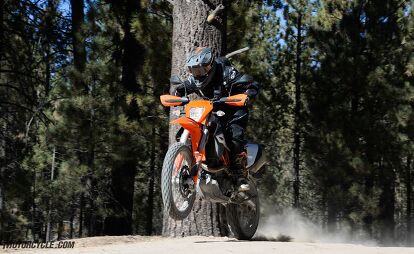
Helmet: Alpinestars S-M10 $649.95
Goggles: 100% Racecraft $75.00
Jacket: Alpinestars Venture R $219.95
Boots: Alpinestars Tech 10 $599.95
Jersey: Alpinestars Racer Tech Jersey $45
Pants: Alpinestars Venture R Pants $150
Armor: Alpinestars Bionic Pro Jacket $240
2019 KTM 690 Enduro R Specifications | |
|---|---|
| MSRP | $11,699 |
| Engine Type | Liquid-cooled Single-cylinder, 4-stroke engine |
| Bore x Stroke | 105 mm x 80 mm |
| Displacement | 693cc |
| Power | 73.8 hp (claimed) |
| Torque | 54.2 lb-ft. (claimed) |
| Starter | Electric starter |
| Lubrication | Forced oil lubrication with 2 oil pumps |
| Transmission | 6-speed |
| Clutch | PASC slipper clutch, hydraulically actuated |
| EMS | Keihin EMS with RBW, twin ignition |
| Drive | X-Ring 5/8 x 1/4″ |
| Frame | Chrome-moly tubular space frame, powder-coated |
| Front Suspension | WP XPLOR 48 upside-down fork with adjustable damping, 250 mm of travel |
| Rear Suspension | WP XPLOR with Pro-Lever linkage, 250 mm of travel |
| Front Brake | Brembo twin-piston floating calliper, 300 mm disc |
| Rear Brake | Single-piston floating calliper, 240 mm disc |
| ABS | Bosch 9.1 MP (incl. Cornering-ABS and offroad mode, disengageable) |
| Steering head angle | 62.3° |
| Ground Clearance | 10.6 inches |
| Seat Height | 35.8 inches |
| Tank Capacity (approx.) | 13.5 l (3.6 gallons) |
| Dry Weight | 322 pounds (claimed) |
| Fuel Consumption | 59.4 mpg (claimed) 55 mpg (observed) |

Ryan’s time in the motorcycle industry has revolved around sales and marketing prior to landing a gig at Motorcycle.com. An avid motorcyclist, interested in all shapes, sizes, and colors of motorized two-wheeled vehicles, Ryan brings a young, passionate enthusiasm to the digital pages of MO.
More by Ryan Adams

































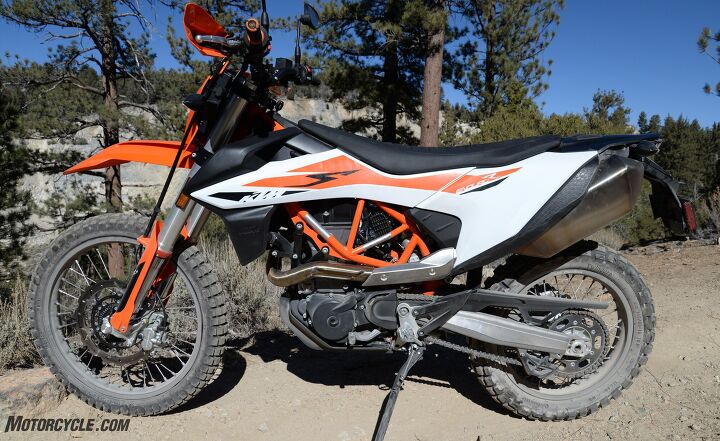














































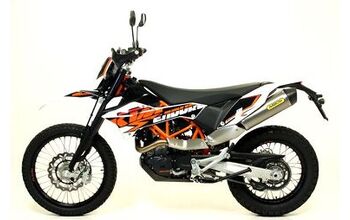

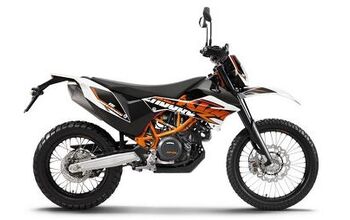



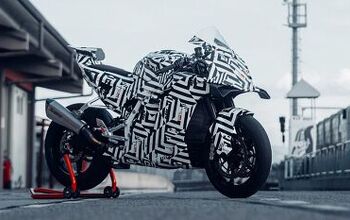








Comments
Join the conversation
“Jack of all master of none” is pretty much the definition of any adventure bike, isn’t it?
Revisited this article as I decided to buy a Husky 701 yesterday. My revised stable is '18 300 XC, '23 701 and '14 Super Tenere. My '06 FZ1 and '10 Berg 450 are going away. The 'Berg particularly hurts as it is such a cool and semi rare machine, but I never ride it due to having the 300, which is more fun to ride than man should be allowed to have...
The 690 and 701 are essentially identical as are their prices. I like the 690's looks better but the 701 comes with a 2 year 24K mile warranty vs. the 690, which only has a 1 year 12K mile warranty. It was another $800 to buy another year of warranty on the 690, so I took the 701 with it's "free" extra year of warranty. My friend's 690 has been very reliable, but whatever. No doubt I will come to love the 701's appearance and I will spice it up with a DeCal Works kit anyway.
The 690/701 is not a master of anything, but I kind of enjoy that. It is simply a dual sport with a big honkin' ridiculous engine in it, and that is a recipe for fun. Fortunately I am tall enough and experienced enough off road (short people and off road noobs have no reason to apply here) and that engine really is amazing.
I rode a friend's 690, which had a perfectly functioning quick shifter in off road mode with it's TC off and the ensuing multi gear lazy hanging wheelies were almost as good as "back in the day" on my '83 XL600. Good God, what an engine. Good suspension too.
Gotta get busy doing the usual mods - first things first, a Seat Concepts saddle. Then a Rottweiler fueling dongle (to remove the O2 sensor and richen up the very lean and hot running part throttle mixture), AXP skid plate with a tail on it to protect the linkage, and a rear disc fin. I like to buy bikes in the winter as it gives me time to go through them and set them up.